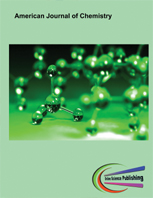Isoeugenol's biotransformation to vanillin using microorganisms
DOI:
https://doi.org/10.55284/ajc.v10i1.1301Keywords:
Accession number OR140859, Aeromonas veronii, Biotransformation, HPLC, Isoeugenol, NCBI, Vanillin.Abstract
The biotechnological route of producing natural biological food products is preferred over synthetically created ones. One such pathway is biotransformation, which entails the chemical transformation of one substance into another using microorganisms acting as biocatalysts. One crucial process in green chemistry is biotransformation, which results in the biological production of numerous valuable chemicals. Due to its distinct aroma, vanillin is one of the most widely used flavors in the world. It is used in ice cream, cakes, biscuits, chocolates, and cosmetics. Compared to chemically synthesized vanillin, biologically produced vanillin has very few or no radicals, which is why it has very little or no negative effects on humans. Biological precursors such as eugenol and isoeugenol, as well as ferulic acids, can be utilized in the production of vanillin. Pure bacterial cultures were isolated from soil (isolates coded as DSH1001 to DSH1004) and identified by various biochemical reactions as Gram-negative rods. The microorganism identified by 16S ribosomal sequencing with accession number OR140859 can convert isoeugenol to vanillin. Their capacity to biotransform isoeugenol was also investigated. Using HPLC, a final screening of the selected bacterial isolate was carried out at a temperature of 37°C, pH 7.2, agitation rate of 150 rpm, and an initial isoeugenol concentration of 0.01%. The food sector can profit from the commercial production of vanillin by biological means.

